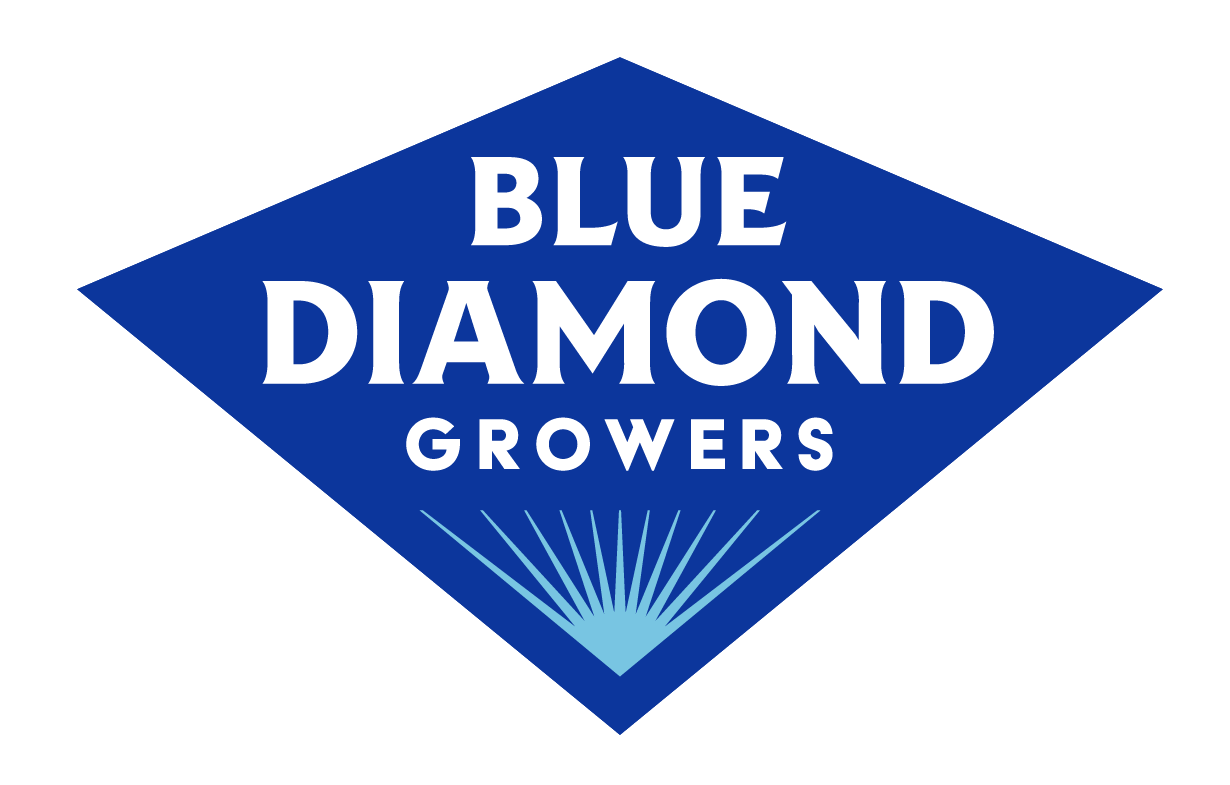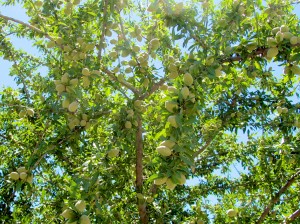Blue Diamond Almonds – Almond Bloom Report – June 3, 2013
This report covers conditions and observations made between Monday, April 29 and Sunday, June 2, 2013. The next report is scheduled for Monday, July 1, 2013. However, in the event of any significant occurrences prior to that date, this site will be updated as soon as possible.
Northern California Almond Bloom Report –
Mild temperatures dominated the weather in the Sacramento Valley during May, but were accompanied by brisk winds that hindered some orchard activities and offset any water savings provided by the cooler conditions. Maximum temperatures peaked early in the period and at mid-month when readings reached into the upper 80’s and lower 90’s. However, highest temperatures were reported in the periods closing days when readings rose above 100 degrees in the warmest locations. Meanwhile, coolest days during the period reached only into the upper 60’s and lower 70’s under the influence of two cut-off low pressure systems that spread scattered showers across the region dropping from a few hundredths to as much as 0.2 inch of rain. Morning minimum readings were a bit more stable during the month, ranging predominately between the upper 40’s and lower 60’s.
Winds continued to play a dominant role in the region’s weather with speeds reaching into the teens and twenties on many days, even during the warmer days of the month. In addition to increasing water needs, the winds also interrupted some orchard operations that require calmer conditions.
Irrigation played a dominant role in the grower’s activities during May as they worked to support the developing crop. Observers have noted that nuts of all but the latest varieties are now fully solidified and have reached their maximum weight. While the drying winds reduced the threat of fungal infection, growers were forced to deal with increased water consumption, drawing on the already tight water supplies needed to get them through the growing season. Observers also noted some degree of branch breakage in the more heavily laden orchards as a result of the winds.
Leaf-Footed Plant Bug, LFPB made its presence known in the Sacramento Valley, though not to the same extent as in the San Joaquin Valley. Growers reported infestations in the more attractive varieties such as Fritz, Aldrich and Sonora and treated as needed. However, infestations of web-spinning mites, which had flared in spite of the occasional and admittedly spotty rainfall, drew a greater amount of attention. Accordingly, applications of preventative miticides targeted at problem species were completed as growers worked to thwart the spread of damaging populations.
Information gathered using new protocols for nitrogen management, coupled with close observations of the orchards assisted growers in fine-tuning nitrogen applications needed to carry the crop to harvest. Growers with low volume irrigation systems are able to add fertilizer required materials to their irrigations, saving passes through the orchards with machinery while also employing more efficient materials.
In the coming weeks, growers will continue irrigations even as they work to manage weed growth and plan treatments for Navel Orange Worm and ant control as the orchards approach the hull split season.
Central California Almond Bloom Report –
Breezy conditions dominated the central region’s weather during May, holding temperatures below seasonal normal levels for much of the period. Variable conditions allowed daily maximums to reach their peak values several times during the month, first as the period began and again at mid-month when readings reached into the upper 80’s and lower 90’s and finally in the period’s closing days when readings approached the 100 degree mark. In between, temperatures dropped into the lower 70’s in all areas of the region, nearly 15 degrees below normal values for the period as cut-off low-pressure systems swept over the state. While forecasters had called for the possibility of scattered showers, precipitation was scarce with wettest locations reporting only a few hundredths of an inch. Morning lows exhibited a bit more stability than the daily maximums, with most mornings producing minimum values between the upper 40’s to upper 50’s, while warmest mornings dipped only into the lower 60’s.
Winds continued to play a role in the region’s weather, with wind speeds reaching above 10 mph on the majority of days and above 20 mph on quite a few as well. While growers reported some blown over trees and broken branches, greatest impact from the winds was produced by the drying effects of the winds, which held water consumption at elevated levels in spite of the lower temperatures.
Observers have reported that the first solid kernels in the Nonpareil variety were noted at mid-month along the west side of the region approximately 10 days ahead of last year. This is a direct result of the warm temperatures experienced during the weeks following the completion of the bloom. Lower temperatures experienced during May failed to significantly impact the pace of development and observers have noted that kernels in all varieties are now fully solidified.
Grower’s activities during the period were focused primarily on irrigation, fertility and pest management. Many have explored new protocols for nitrogen management developed by the University of California and have been adapting their applications accordingly. However, most attention was given to management of insect pests as a result of increased pressure from Leaf-Footed Plant Bugs, LFPB, which made their appearance in many orchards. The insect can also damage the kernels after solidification, increasing reject levels by causing gumming and a discoloration of the kernel at the feeding site known as Brown Spot. Growers with Fritz, Aldrich, Sonora, Monterey and Price were particularly vigilant given the insect’s preference for these varieties and their ability to cause significant crop losses. While growers were reluctant to employ a disruptive insecticide that could also impact beneficial insect populations, the rapid spread of this aggressive pest forced many to treat their orchards to eliminate the infestations. Given that most growers were also beginning treatments with preventative miticides targeted at damaging mite species, growers were able to add materials required to control the Plant Bugs to the application, saving an additional pass through the orchards.
A few growers with Fritz also reported symptoms of Bacterial Spot, which causes the symptoms similar to Leaf-Footed Plant Bug, a clear “gumming” of sap dripping from the hull as well as foliar damage.
As is normally the case for the period, irrigation was prime activity. Growers have been closely monitoring their orchard’s moistures needs, balancing requirements against the supply of water available. These efforts will continue into the fall. Growers will also be monitoring Navel Orange Worm traps as they work to effectively and efficiently time treatments to control this traditional insect pest prior to harvest. Those with excessive mummy nuts remaining in the trees from last year’s crop will be particularly vigilant.
Southern California Almond Bloom Report –
Windy conditions and variable, but generally mild temperatures dominated the weather in the southern region during May. Daily maximum temperatures reached their greatest values in the period’s closing days when readings reached just over 100 degrees. Otherwise, maximum temperatures varied between the mid and upper 70’s and the low to mid 90’s for much of the period as pulses of moisture passed over the state, dropping several hundredths of an inch of rain around the region. Morning minimum temperatures were equally mild, with readings reported predominately between the lower 50’s and lower 60’s. Observers noted that daily winds continued to influence grower’s activities during the period. Wind speeds on many days reached well into the teens, increasing moisture consumption and hindering grower’s pest management efforts.
Growers in the southern San Joaquin Valley enjoyed the break from the increasing temperatures normally experienced during May while working to provide for the needs of the developing crop. Observers have reported that kernels of all varieties are now fully solidified, signifying the possibility of a normal start of the harvest.
Weed control, fertilization and irrigation were prime activities during the month; however, pest management became a dominant task for many in the region. While mowing excessive vegetation, growers were also monitoring their orchards for the presence of Leaf-Footed Plant Bug, LFPB, which infested many orchards around the region. Growers with Fritz, Aldrich, Sonora, Monterey and Butte were particularly vigilant given the insect’s preference for those varieties. Feeding by the adult insect causes a clear exudate on the hull and kills the kernel if attacked prior to solidification. Later feeding can cause gummy kernels and Brown Spot, both of which are classified as rejects. Growers have also been watching rising populations of web-spinning mites. Elevated temperatures earlier in the season promoted development of insect and mite pests, while windy conditions have made proper treatments difficult. Additionally, winds have covered trees with dust, reducing the efficacy of preventative miticide applications. While growers were reluctant to employ an insecticide to control LFPB that would also disrupt beneficial insect populations, increasing infestations forced many to treat. Fortunately, observers are now reporting that the LFPB has diverted its attention towards pistachio plantings now that the almond shells have hardened.
Growers have been also monitoring more traditional pests such as Navel Orange Worm, NOW, and ants. Growers and Pest Control Advisors are reporting that trap catches in the newly employed pheromone traps for NOW have been quite high. However, all are working to interpret the numbers from the new traps and their comparison to the more traditional monitoring methods. Growers will begin treatments to control NOW within the next few weeks. Growers will also begin applications of bait formulations targeted to reduce populations of Southern Fire Ant and Pavement Ants that typically feed on almonds during the harvest.
Water management continues to be a prime activity. Growers have been forced to rely increasingly on their deep wells for water this year as they work to supplement deliveries from local irrigations and have noted that pumping levels within their wells are dropping. Water deliveries from the Madera Irrigation District will begin within the next week, while supplies from the Chowchilla Water District will be available in mid-June. As noted in previous reports, deliveries from the federal Central Valley Project remain at 20% of contacted amounts. While the cooler temperatures experienced during May provided a relaxation in water consumption, this was partially offset by the windy conditions.
Forecasters are calling for the return to more normal, seasonally warm temperatures during June.

